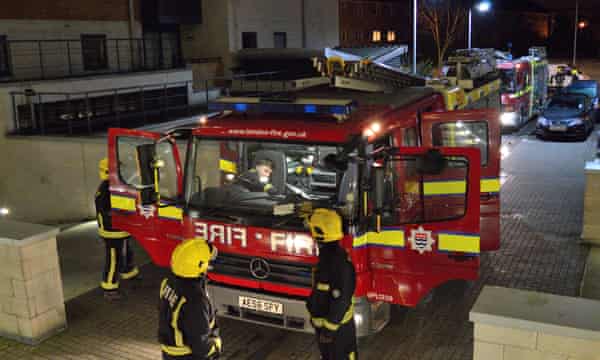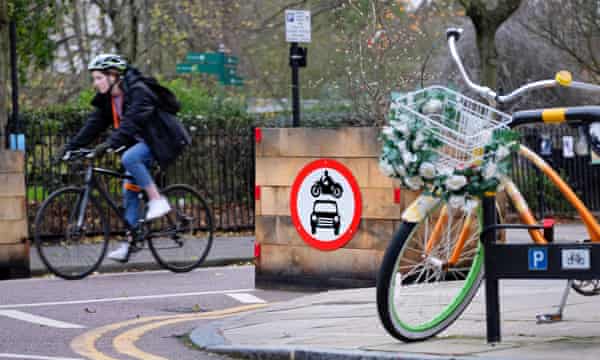If you were to read certain newspapers for long enough, the message would seem clear: the main cause of traffic congestion is measures to boost walking and cycling – that is, separated cycle lanes, and so-called low-traffic neighbourhoods, or LTNs.
LTNs, schemes to dissuade through traffic on smaller residential streets by filters permeable to people travelling by foot or cycle, but not by private motor vehicle – whether camera-enforced or in the physical form of planters or bollards – are at the centre of a particularly fierce transport-based culture war.
The regular focus for this is access for emergency vehicles. Stories about ambulances or fire crews supposedly held up by badly implemented or not consulted-on planters are a near-daily staple of some news outlets.
This article is an attempt to get to the facts, and in turn to use the row about emergency access as a microcosm for the wider, and often depressingly toxic, debate on LTNs. The examples and studies cited will, I’m afraid, come from London, given the recent spread of LTNs in the capital, and the resultant fact that the research tends to be focused there.
One thing is pretty clear: there is virtually no evidence that LTNs routinely, or even regularly, delay emergency services. The single proper study of the phenomenon found no delays; neither the London ambulance service (LAS) or London fire brigade (LFB) believe there is a general problem; and the handful of attempts to prove a widespread issue fall apart on examination.
Equally – as more than one thing can be true at once – that doesn’t mean that there are never delays which could be attributable to LTNs. There are some emergency service staff who have perfectly rational complaints about aspects of how some schemes are implemented.
Examining traffic patterns and attributing delays to particular causes is a hugely complex business, and the issue for supporters of LTNs is that they are seeking, to an extent, to prove a negative. The burden of evidence is arguably more with the opponents to prove there is an issue. And here, it seems, they have failed.

The one specific study I know about into the issue, led by public health academic Dr Anna Goodman, and published late last year in the journal Transport Findings, looked into the very specific issue of whether LTN schemes in the north-east London borough of Waltham Forest had affected fire crews.
The LFB keeps detailed data on response times and the stated reasons for any delays. Studying more than 23,000 incidents in the borough between 2012 and 2020, the study found no evidence that LTNs, when they were introduced – Waltham Forest was an early adopter – slowed crews. On the boundary of the LTNs, in fact, response times actually quickened.
There was, however, one interesting phenomenon: the proportion of the delays put down to “traffic calming measures” – the metric that covers LTNs – rose, particularly when newer LTNs had been built.
The authors argue that this seemed largely down to the academic phenomenon known as “salience”: the fact that some things are just more memorable than others. Hence, a crew having to detour round a new set of bollards are much more likely to note this in their report than, for example, being held up by traffic.
The corollary to the Waltham Forest report is a news story in the Times last month, which used the extensive LFB data to argue that LTNs did appear to be a problem, citing the fact that delays attributed to “traffic calming measures” rose much more steeply in boroughs with new LTNs than those without – by 35% as against 2.8%.
While superficially notable, the article is not academically credible, for several reasons. One is the impact of salience on the results. Another is that London boroughs are big and complex places, and there was no attempt made to account for the many other factors that could be involved – not least the very different traffic patterns of lockdown.
Finally, the sample size is small. An analysis by the Bike is Best campaign looked at the LFB data and found that “traffic calming measures” was a tiny proportion of the total number of recorded delays, ranging between 1.3% and 1.5% in recent years.
The LFB is pretty clear in its view, saying it backs measures to boost active travel, and works closely with councils over how they are implemented.

The LAS doesn’t keep similarly micro-level response data, and it is with ambulances, at least in London, where the LTN picture becomes a little more complex.
A key part of this is very basic logistics. Fire crews are based at stations, and tend to tackle incidents locally before returning; as such, their drivers will often know the streets and routes well. In contrast, ambulance crews and paramedics will set off from a base at the start of their shift, but are then often sent from incident to hospital to incident, and can end up more or less anywhere across the capital.
As a result, ambulance drivers are much more reliant on navigation systems, which are not always immediately updated with new LTN schemes. The LAS has its own bespoke navigation system, but I’m told it’s not entirely trusted, with drivers often using apps on their phones. Some LTNs have camera-enforced filters, through which emergency services can pass – but if a crew is relying on, say, Waze or Google Maps, they will not be directed that way.
The LAS also publicly backs moves to boost cycling and walking – not least given the huge number of medical cases connected to inactive living – but is keen to work with councils, and Transport for London, to make sure its views are heard.
If you speak to ambulance staff, some will say that LTNs can be a polarising subject, and that they not uncommonly come up when the service holds engagement events with senior managers.
Some of this, yet again, comes back to our old friend salience: squeezing past congested traffic is the daily, normalised routine of a London ambulance driver; taking a side-route and finding yourself suddenly stopped by a new planter is not. Similarly, the amount of kit paramedics need to take on shift mean many drive to and from work, often giving them a car-centric view of the city.
But beyond that, it does seem there are genuine concerns with aspects of some LTN schemes, and a desire for elements of them to be amended. To an extent, this is stating the obvious. No one would expect every local authority to implement all its major schemes, roads-based or otherwise, perfectly first time – that is precisely why the LFB and LAS liaise so closely.
There is, however, a fairly important point here: advocates of LTNs don’t tend to claim they are all without any fault, or at least as far as I’ve seen. In contrast, a fairly sizeable proportion of the opponents, or at least the shoutier elements who pile into debates on social media and local message boards, argue that LTNs necessarily slow up all traffic, and thus imperil lives due to delayed fire and ambulance crews.
This isn’t the case. No studies find it is the case. No emergency services say it is the case. There is no credible evidence of a systemic, routine problem. That is perhaps the one certainty in a debate which is considerably more complex and nuanced than the headlines would have you believe.